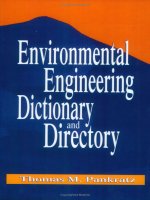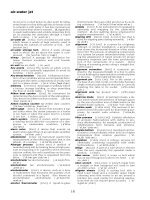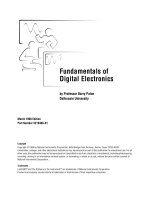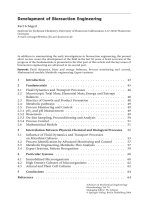engineering thermodynamics
Bạn đang xem bản rút gọn của tài liệu. Xem và tải ngay bản đầy đủ của tài liệu tại đây (3.76 MB, 107 trang )
Tarik Al-Shemmeri
Engineering Thermodynamics
Download free eBooks at bookboon.com
2
Engineering Thermodynamics
© 2010 Tarik Al-Shemmeri & Ventus Publishing ApS
ISBN 978-87-7681-670-4
Download free eBooks at bookboon.com
3
Contents
Engineering Thermodynamics
Contents
Preface
6
1.
1.1
1.2
1.3
1.4
General Deinitions
Thermodynamic System
Thermodynamic properties
Quality of the working Substance
Thermodynamic Processes
7
7
8
9
10
2.
2.1
2.2
2.3
2.4
2.5
2.6
2.7
Thermodynamics working luids
The Ideal Gas
Alternative Gas Equation During A Change Of State:
Thermodynamic Processes for gases
Van der Waals gas Equation of state for gases
Compressibility of Gases
The State Diagram – for Steam
Property Tables And Charts For Vapours
11
11
13
13
14
16
17
19
3.
3.1
3.1.1
3.1.2
3.2
Laws of Thermodynamics
Zeroth Law of Thermodynamics
Methods of Measuring Temperature
International Temperature Scale
First Law of Thermodynamics
38
38
38
39
40
e Graduate Programme
for Engineers and Geoscientists
I joined MITAS because
I wanted real responsibili
Maersk.com/Mitas
Real work
International
Internationa
al opportunities
ree work
wo
or placements
Month 16
I was a construction
supervisor in
the North Sea
advising and
helping
foremen
he
solve
problems
s
Download free eBooks at bookboon.com
4
Click on the ad to read more
Contents
Engineering Thermodynamics
3.2.1
3.2.2
3.2.3
3.2.4
3.2.5
3.2.6
3.2.6
3.3
3.3.1
3.3.2
3.3.3
3.4
3.4.1
First Law of Thermodynamics Applied to closed Systems
Internal Energy
Speciic Heat
System Work
First Law of Thermodynamics Applied to Closed Systems (Cycle)
First Law of Thermodynamics Applied to Open Systems
Application of SFEE
The Second Law of Thermodynamics
Second Lay of Thermodynamics – statements:
Change of Entropy for a Perfect Gas Undergoing a Process
Implications of the Second Law of Thermodynamics
Third Law
The Third Law of Thermodynamics - Analysis
4.
4.1
4.2
4.3
Thermodynamics Tutorial problems
First Law of Thermodynamics N.F.E.E Applications
First Law of Thermodynamics S.F.E.E Applications
General Thermodynamics Systems
40
40
41
44
45
46
46
50
50
52
52
54
55
102
102
103
104
www.job.oticon.dk
Download free eBooks at bookboon.com
5
Click on the ad to read more
Preface
Engineering Thermodynamics
Preface
Thermodynamics is an essential subject taught to all science and engineering students. If the
coverage of this subject is restricted to theoretical analysis, student will resort to memorising the
facts in order to pass the examination. Therefore, this book is set out with the aim to present this
subject from an angle of demonstration of how these laws are used in practical situation.
This book is designed for the virtual reader in mind, it is concise and easy to read, yet it presents all
the basic laws of thermodynamics in a simplistic and straightforward manner.
The book deals with all four laws, the zeroth law and its application to temperature measurements.
The first law of thermodynamics has large influence on so many applications around us, transport
such as automotive, marine or aircrafts all rely on the steady flow energy equation which is a
consequence of the first law of thermodynamics. The second law focuses on the irreversibilities of
substances undergoing practical processes. It defines process efficiency and isentropic changes
associated with frictional losses and thermal losses during the processes involved.
Finally the Third law is briefly outlined and some practical interrepretation of it is discussed.
This book is well stocked with worked examples to demonstrate the various practical applications
in real life, of the laws of thermodynamics. There are also a good section of unsolved tutorial
problems at the end of the book.
This book is based on my experience of teaching at Univeristy level over the past 25 years, and my
student input has been very valuable and has a direct impact on the format of this book, and
therefore, I would welcome any feedback on the book, its coverage, accuracy or method of
presentation.
Professor Tarik Al-Shemmeri
Professor of Renewable Energy Technology
Staffordshire University, UK
Email:
Download free eBooks at bookboon.com
6
1. General Deinitions
Engineering Thermodynamics
1. General Definitions
In this sectiongeneral thermodynamic terms are briefly defined; most of these terms will be
discussed in details in the following sections.
1.1 Thermodynamic System
Thermodynamics is the science relating heat and work transfers and the related changes in the
properties of the working substance. The working substance is isolated from its surroundings in
order to determine its properties.
System - Collection of matter within prescribed and identifiable boundaries. A system may be
either an open one, or a closed one, referring to whether mass transfer or does not take place across
the boundary.
Surroundings - Is usually restricted to those particles of matter external to the system which may
be affected by changes within the system, and the surroundings themselves may form another
system.
Boundary - A physical or imaginary surface, enveloping the system and separating it from the
surroundings.
Boundary
System
Surroundings
In flow
Out flow
Motor
Figure 1.1: System/Boundary
Download free eBooks at bookboon.com
7
1. General Deinitions
Engineering Thermodynamics
1.2 Thermodynamic properties
Property - is any quantity whose changes are defined only by the end states and by the process.
Examples of thermodynamic properties are the Pressure, Volume and Temperature of the working
fluid in the system above.
Pressure (P) - The normal force exerted per unit area of the surface within the system. For
engineering work, pressures are often measured with respect to atmospheric pressure rather than
with respect to absolute vacuum.
Pabs = Patm + Pgauge
In SI units the derived unit for pressure is the Pascal (Pa), where 1 Pa = 1N/m2. This is very small
for engineering purposes, so usually pressures are given in terms of kiloPascals (1 kPa = 103 Pa),
megaPascals (1 MPa = 106 Pa), or bars (1 bar = 105 Pa). The imperial unit for pressure are the
pounds per square inch (Psi)) 1 Psi = 6894.8 Pa.
Specific Volume (V) and Density (ρ )
For a system, the specific volume is that of a unit mass, i.e.
v=
volume
mass
Units are m3/kg.
It represents the inverse of the density, v = 1 .
ρ
Temperature (T) - Temperature is the degree of hotness or coldness of the system. The absolute
temperature of a body is defined relative to the temperature of ice; for SI units, the Kelvin scale.
Another scale is the Celsius scale. Where
the ice temperature under standard ambient pressure at sea level is: 0oC ≡ 273.15 K
and the boiling point for water (steam) is:
100oC ≡ 373.15 K
The imperial units of temperature is the Fahrenheit where
ToF = 1.8 x ToC + 32
Internal Energy(u) - The property of a system covering all forms of energy arising from the
internal structure of the substance.
Enthalpy (h) - A property of the system conveniently defined as h = u + PV where u is the internal
energy.
Download free eBooks at bookboon.com
8
1. General Deinitions
Engineering Thermodynamics
Entropy (s) - The microscopic disorder of the system. It is an extensive equilibrium property.
This will be discussed further later on.
1.3 Quality of the working Substance
A pure substance is one, which is homogeneous and chemically stable. Thus it can be a single
substance which is present in more than one phase, for example liquid water and water vapour
contained in a boiler in the absence of any air or dissolved gases.
Phase - is the State of the substance such as solid, liquid or gas.
Mixed Phase - It is possible that phases may be mixed, eg ice + water, water + vapour etc.
Quality of a Mixed Phase or Dryness Fraction (x)
The dryness fraction is defined as the ratio of the mass of pure vapour present to the total mass of
the mixture (liquid and vapour; say 0.9 dry for example). The quality of the mixture may be
defined as the percentage dryness of the mixture (ie, 90% dry).
Saturated State - A saturated liquid is a vapour whose dryness fraction is equal to zero. A
saturated vapour has a quality of 100% or a dryness fraction of one.
Superheated Vapour - A gas is described as superheated when its temperature at a given pressure
is greater than the saturated temperature at that pressure, ie the gas has been heated beyond its
saturation temperature.
Degree of Superheat - The difference between the actual temperature of a given vapour and the
saturation temperature of the vapour at a given pressure.
Subcooled Liquid - A liquid is described as undercooled when its temperature at a given pressure
is lower than the saturated temperature at that pressure, ie the liquid has been cooled below its
saturation temperature.
Degree of Subcool - The difference between the saturation temperature and the actual temperature
of the liquid is a given pressure.
Triple Point - A state point in which all solid, liquid and vapour phases coexist in equilibrium.
Critical Point - A state point at which transitions between liquid and vapour phases are not clear.
for H2O:
Download free eBooks at bookboon.com
9
1. General Deinitions
Engineering Thermodynamics
•
•
•
•
•
•
PCR = 22.09 MPa
TCR = 374.14 oC (or 647.3 oK)
vCR = 0.003155 m3/kg
uf = ug =2014 kJ/kg
hf =hg = 2084 kJ/kg
sf = sg =4.406 kJ/kgK
1.4 Thermodynamic Processes
A process is a path in which the state of the system change and some properties vary from their
original values. There are six types of Processes associated with Thermodynamics:
Adiabatic : no heat transfer from or to the fluid
Isothermal : no change in temperature of the fluid
Isobaric : no change in pressure of the fluid
Isochoric : no change in volume of the fluid
Isentropic : no change of entropy of the fluid
Isenthalpic : no change of enthalpy of the fluid
Download free eBooks at bookboon.com
10
2. Thermodynamics working luids
Engineering Thermodynamics
2. Thermodynamics working fluids
Behaviour of the working substance is very essential factor in understanding thermodynamics. In
this book, focus is given to pure substances such as gases and steam properties and how they are
interrelated are important in the design and operation of thermal systems.
The ideal gas equation is very well known approximation in relating thermal properties for a state
point, or during a process. However, not all gases are perfect, and even the same gas, may behave
as an ideal gas under certain circumstances, then changes into non-ideal, or real, under different
conditions. There are other equations, or procedures to deal with such conditions. Steam or water
vapour is not governed by simple equations but properties of water and steam are found in steam
tables or charts.
2.1 The Ideal Gas
Ideally, the behaviour of air is characterised by its mass, the volume it occupies, its temperature and
the pressure condition in which it is kept. An ideal gas is governed by the perfect gas equation of
state which relates the state pressure, volume and temperature of a fixed mass (m is constant) of a
given gas ( R is constant ) as:
PV
= mR
T
Where
(1)
P – Pressure (Pa)
V – Volume (m3)
T – Absolute Temperature (K)
T(K) = 273 + t ( C )
m – mass (kg)
R – gas constant (J/kgK)
The equation of state can be written in the following forms, depending on what is needed to be
calculated
1. In terms of the pressure
2. In terms of the volume
3. In terms of the mass
4. In terms of the temperature
mRT
V
mRT
V=
P
PV
m=
RT
PV
T=
mR
P=
Download free eBooks at bookboon.com
11
(2)
(3)
(4)
(5)
2. Thermodynamics working luids
Engineering Thermodynamics
5. In terms of the gas constant
6. In terms of the density
PV
mT
m
P
ρ= =
V RT
R=
(6)
(7)
The specific gas constant R, is a property related to the molar mass (M) in kg/kmol, of the gas and
the Universal gas constant Ro as
R = Ro / M
(8)
where Ro = 8314.3 J/kgK
The ideal gas equation can also be written on time basis, relating the mass flow rate (kg/s) and the
volumetric flow rate (m3/s) as follows:
P Vt = mt R T
(9)
Download free eBooks at bookboon.com
12
Click on the ad to read more
2. Thermodynamics working luids
Engineering Thermodynamics
2.2 Alternative Gas Equation During A Change Of State:
The equation of state can be used to determine the behaviour of the gas during a process, i.e. what
happens to its temperature, volume and pressure if any one property is changed. This is defined by
a simple expression relating the initial and final states such as :
P1V1 P2V2
=
T1
T2
(10)
this can be rewritten in terms of the final condition, hence the following equations are geerated :
Final Pressure
P2 = P1 x
T2 V1
x
T1 V2
(11)
Final Temperature
T2 = T1 x
P2 V2
x
P1 V1
(12)
Final Volume
V2 = V1 x
P1 T2
x
P2 T1
(13)
2.3 Thermodynamic Processes for gases
There are four distinct processes which may be undertaken by a gas (see Figure 2.1):a) Constant volume process, known as isochoric process; given by:-
P1 P2
=
T1 T2
(14)
b) Constant pressure process; known as isobaric process, given by:-
V1 V2
=
T1 T2
(15)
c) Constant temperature process, known as isothermal process, given by:-
P1V1 = P2V2
(16)
d) Polytropic process given by:-
Download free eBooks at bookboon.com
13
2. Thermodynamics working luids
Engineering Thermodynamics
P1V1 = P2V2
n
n
(17)
Note when n = Cp/Cv, the process is known as adiabatic process.
Pressurere
isobaric
isothermal
adiabatic
isochoric
Volume
Figure 2.1: Process paths
2.4 Van der Waals gas Equation of state for gases
The perfect gas equation derived above assumed that the gas particles do not interact or collide
with each other. In fact, this is not true. The simpliest of the equations to try to treat real gases was
developed by Johannes van der Waals. Based on experiments on pure gases in his laboratory, van
der Waals recognized that the variation of each gas from ideal behavior could be treated by
introducing two additional terms into the ideal gas equation. These terms account for the fact that
real gas particles have some finite volume, and that they also have some measurable intermolecular
force. The two equations are presented below:
PV = mRT
P=
RT
a
− 2
v −b v
(18)
where v is the specific volume ( V/m ), and the Numerical values of a & b can be calculated as
follows:
27 ⋅ R ⋅ T
a=
64 ⋅ P
2
2
critical
and
b=
R⋅T
8⋅ P
critical
( 19)
critical
critical
Table 2.1, presents the various thermal properties of some gases and the values of the constants (a,
and b) in Van der Waals equation.
Download free eBooks at bookboon.com
14
2. Thermodynamics working luids
Engineering Thermodynamics
Substance
Chemical
Formula
Air
O2 +
3.76 N2
NH3
Ammonia
Molar
Mass
M
(kg/kmol)
28.97
Gas
constant
R (J/kgK)
Critical
Pressure
PC (MPa)
286.997
Critical
Temp
TC
(K)
132.41
Van der Waals
Constants
a
b
3.774
161.427
0.00126
17.03
488.215
405.40
11.277
1465.479
0.00219
Carbon
Dioxide
Carbon
Monoxide
Helium
CO2
44.01
188.918
304.20
7.386
188.643
0.00097
CO
28.01
296.833
132.91
3.496
187.825
0.00141
He
4.003
2077.017
5.19
0.229
214.074
0.00588
Hydrogen
H2
2.016
4124.157
33.24
1.297
6112.744
0.01321
Methane
CH4
16.042
518.283
190.70
4.640
888.181
0.00266
Join the Vestas
Graduate Programme
Experience the Forces of Wind
and kick-start your career
As one of the world leaders in wind power solutions with wind turbine installations in over 65
countries and more than 20,000 employees
globally, Vestas looks to accelerate innovation
through the development of our employees’ skills
and talents. Our goal is to reduce CO2 emissions
dramatically and ensure a sustainable world for
future generations.
Read more about the Vestas Graduate
Programme on vestas.com/jobs.
Application period will open March 1 2012.
Download free eBooks at bookboon.com
15
Click on the ad to read more
2. Thermodynamics working luids
Engineering Thermodynamics
Nitrogen
N2
28.016
296.769
126.20
3.398
174.148
0.00138
Oxygen
O2
32.00
259.822
154.78
5.080
134.308
0.00099
R12
CC12F2
120.92
68.759
385
4.120
71.757
0.00080
Sulpher
Dioxide
Water
Vapour
SO2
64.06
129.789
431
7.870
167.742
0.00089
H2O
18.016
461.393
647.3
22.090
1704.250
0.00169
Table 2.1 Van Der Waals Constants for some gases
2.5 Compressibility of Gases
Compressibility factor, Z, is a measure of deviation from the ideal gas.
Z=
P.v
R.T
(20)
Where v is the specific volume ( V/m ),
Note: Z = 1 for an ideal gas.
As Z approaches 1 for a gas at given conditions, the behavior of the gas approaches ideal gas behavior.
Although, different gases have very different specific properties at various conditions; all gases behave
in a similar manner relative to their critical pressure, Pcr and critical temparature, Tcr.
Hence, the gas pressures and temperatures are normalized by the critical values to obtain the
reduced pressure, PR and temparature, TR.
defined as
PR=P/Pcr ;
TR=T/Tcr
The reduced values can then be used to determine Z using the Generalized Compressibility Charts
(Figure 2.2)
These charts show the conditions for which Z = 1 and the gas behaves as an ideal gas:
Download free eBooks at bookboon.com
16
2. Thermodynamics working luids
Engineering Thermodynamics
Figure 2.2: Compressibilty Chart
2.6 The State Diagram – for Steam
Processes1-2, 2-3, and 3-4 represents a typical constant pressure heating of water which initially
heated to its boiling point,(1-2),upon continued heat input it starts to evaporate at point 2, it
iscompletelyliquid,then gradually someofthe water becomes vapour tillit reaches point3,where all
the water has evaporated, further heating will makethe water vapour superheated(process 3-4).
Download free eBooks at bookboon.com
17
2. Thermodynamics working luids
Engineering Thermodynamics
D
C
Vapour
A
B
ice
water
Water-vapour
equilibrium
Figure 2.3: Formation of Vapour (Steam)
Download free eBooks at bookboon.com
18
2. Thermodynamics working luids
Engineering Thermodynamics
2.7 Property Tables And Charts For Vapours
Tables are normally available which give data for saturated liquid and saturated vapour, a listing
for a given saturation pressure or temperature, some or all of the quantities vf, vg, uf, uf, ug, hf, hfg,
hg, sf, sfg and sg. The tables enable u, h or s to be obtained for saturated liquid, wet vapour and dry
saturated vapour. Charts for steam are readily available which show h or T as ordinate against s
(specific entropy) as abscissa.
In Paris or Online
International programs taught by professors and professionals from all over the world
BBA in Global Business
MBA in International Management / International Marketing
DBA in International Business / International Management
MA in International Education
MA in Cross-Cultural Communication
MA in Foreign Languages
Innovative – Practical – Flexible – Affordable
Visit: www.HorizonsUniversity.org
Write:
Call: 01.42.77.20.66
www.HorizonsUniversity.org
Download free eBooks at bookboon.com
19
Click on the ad to read more
2. Thermodynamics working luids
Engineering Thermodynamics
Figure 2.4: Temperature – Entropy chart for Water/Steam
Courtesy of: />
Calculations of steam properties in the mixed region:
The dryness fraction is an added property needed to define the mixture of water liquid and vapour
during iits transformation ( condensation or evaporation) and is defined as follows:-
x=
mass of vapour
total mass of the system
(21)
The total mass = mass of vapour + mass of liquid; Hence the system volume along the two-phase,
process 2-3 (Figure 2.3) is:
Download free eBooks at bookboon.com
20
2. Thermodynamics working luids
Engineering Thermodynamics
v = (1 − x ) v f + x v g
(22)
At point state point 2, x = 0
at state point 3, x = 1 (Figure 2.3)
Values of vf and vg and other properties for real substances are normally given in tables. Suffix ‘f’
refers to the liquid; Suffix ‘g’ refers to the dry vapour; and Suffix ‘fg’ refers to the mixed phase.
vfg = vg – vf
hfg = hg – hf
Sfg = Sg – Sf
For wet steam of dryness fraction x
v = (1 – x) . vf + x . vg
= vf + x. (vg –vf )
= vf + x . vfg
Similar relations for u, h and s.
or
v = vf + x vfg
u = uf + x ufg
h = hf + x hfg
s = sf + x sfg
(23)
u = (1 – x) uf + x ug
h = (1 –x) hf + x hg
s = (1 – x) sf + x sg
(24)
p
ts
vf
vg
hf
hg
(kJ/kg)
sf
(kJ/kg.K
)
(kPa)
(oC)
(m3/kg)
(m3/kg)
(kJ/kg)
10
45.81
0.001
14.674
100
99.63
0.00104
200
120.23
500
151.86
(kJ/kg.K)
191.83
2,585
0.6493
8.1502
1.694
417.46
2,676
1.3026
7.3594
0.00106
0.8857
504.7
2,707
1.5301
7.1271
0.00109
0.3749
640.23
2,749
1.8607
6.8213
Download free eBooks at bookboon.com
21
sg
2. Thermodynamics working luids
Engineering Thermodynamics
1000
179.91
0.00112
0.1944
762.81
2,778
2.1387
6.5865
2000
212.42
0.00117
0.0996
908.79
2,800
2.4474
6.3409
10000
311.06
0.00145
0.01803
1407.56
2,725
3.3596
5.6141
20000
365.81
0.00236
0.0058
1,826
2,410
4.0139
4.9269
22120
374.15
0.00317
0.00317
2,084
2,084
4.43
4.43
Table 2.2 Saturated Steam table at selected pressures
Are you remarkable?
Win one of the six full
tuition scholarships for
International MBA or
MSc in Management
Download free eBooks at bookboon.com
22
register
now
rode
www.Nyen
lenge.com
MasterChal
2. Thermodynamics working luids
Engineering Thermodynamics
Enthalpy of Superheated Steam (kJ/kg)
Saturation
Pressure
(bar) Temperature (oC) Saturation
Temperature (oC)
200
250
300
350
400
450
2796
2925
3039
3148
3256
3364
15
198.3
2792
20
212.4
2799
2904
3025
3138
3248
3357
30
233.8
2809
2858
2995
3117
3231
3343
40
250.3
2801
2963
3094
3214
3330
Table 2.3 Superheated Steam table at selected pressures
Worked Example 2.1
Self ignition would occur in the engine using certain brand of petrol if the temperature due to
compression reached 350°C.
Calculate the highest ratio of compression that may be used to avoid pre-ignition if the law of
compression is
PV 1.3 = c
PV 1.4 = c
Calculate the final pressure in each case. Assume inlet condition of 27°C and 1 bar.
Solution
(a)
(b)
V1 T2
=
V 2 T1
1
n −1
1
V1
V2
349 + 273 0.3
=
= 11.36
i 300
V1
V2
349 + 273 0.4
=
= 6.19
ii 300
V
P2 = P1 1
V2
1
n
Download free eBooks at bookboon.com
23
2. Thermodynamics working luids
Engineering Thermodynamics
P2i = 1(11.36)1.3 = 23.5 bar
P2ii = 1(6.19)1.4 = 12.8 bar
Worked Example 2.2
Calculate the density of Ethane at 171 bar and 458K; assume for Ethane:
Tc=305 K
Pc=48.80 bar
R = 319.3 J/kgK
a) assuming it behaves as a perfect gas
b) using the compressibility chart.
Solution:
a) for a perfect gas
ρ=
P
171x10 5
=
= 117 kg / m 3
R.T 319.3 x 458
b) using the com[pressibility chart:
TR = T / TCR = 458 / 305.4= 1.5
PR = P / PCR = 171 / 48.8 = 3.52.7
READ Z from the chart ( Z = 0.8 )
ie 80% less dense compared with the perfect gas behaviour.
Or density = 146 kg/m3
Download free eBooks at bookboon.com
24









